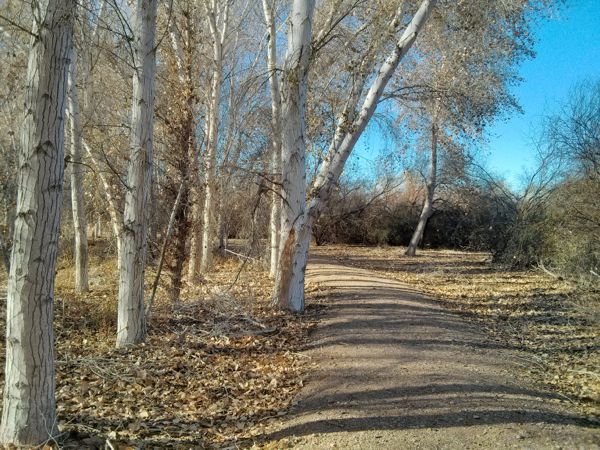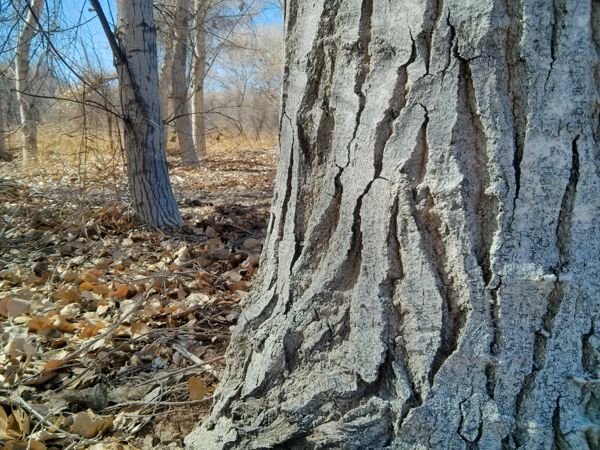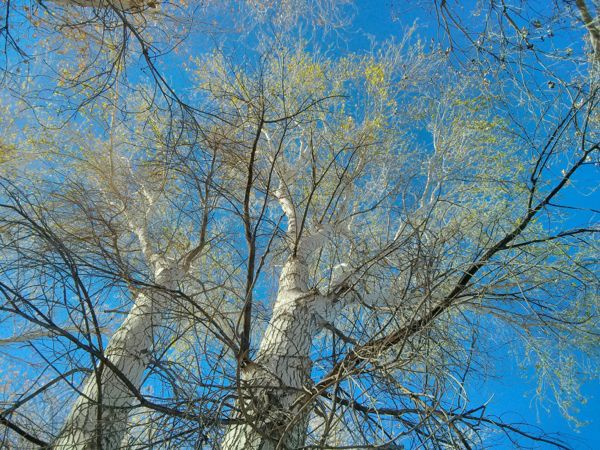Day 143-148: Finding Cottonwoods
 February 3, 2017
February 3, 2017 
One of the hardest moments of this trip for me was when I learned about the destruction of the cottonwood-willow forests of the lower Colorado River. These unique riparian habitats, the ribbons of great trees following the river, were submerged by flooding behind dams, cleared for agriculture, and cut for wood to power steam ships. The land has undergone many changes at our hands, but somehow this felt like a direct hit to my heart. Perhaps it is the rarity of trees in this desert landscape. Perhaps it is the fact that so many creatures depend on these oases of water, shade, and food. Perhaps it is simply that I fell in love with cottonwoods, that they seemed like friends.
So it was a great pleasure when we arrived at Cibola National Wildlife Refuge to see large tracts of planted trees and to realize that many of the southern refuges on the Colorado River have replanted cottonwood and willow stands in an effort to recreate that habitat.
Cibola NWR was established in 1964 to mitigate the effects of channelization and dam construction on the Colorado River in the 30’s and 40’s. Its 18,500 acres are home to a wide variety of wildlife, including wintering geese, ducks, and cranes; migrating songbirds; and native fish. In one portion of the refuge they have planted cottonwoods, willows, and mesquite as habitat for the endangered Southwestern Willow Flycatcher and other wildlife.
A trail follows a mile-long loop through this planting. When I walk into the trees I am reminded of something the poet W.S. Merwin said about his effort of the past 40 years to reforest 19 acres of ruined land where he lives on Maui.
(from What is a Garden)
These plots of planted trees are not yet quite a forest. I can feel the imposition of outside order: the arbitrary square border instead of the meandering line following the water; the equidistant spacing of the trees instead of the clustering in good soil; the suggestion of grid lines instead of groves and copses.
But I can also see that, like Merwin, we are doing our best. And that is a lot. In these 36 acres, the cottonwoods, willows, and mesquite are planted in loops and arcs and bunchings that tries to recreate the diversity and variety of the forest. And it works. This place is a haven for many creatures and a delight to all my senses.

These particular cottonwoods were planted in 1999 so they are not old, as trees go. Yet they are still impressively tall. Their trunks are slender, and no matter what route their limbs take, they all tend up, creating single-pointed or narrow, umbrella-shaped crowns. The bark is white. Or at least it appears white at first glance, shining pale in the strong sunlight or silhouetted against the blue sky. A closer look reveals many shades of silvers and soft browns. The young trees are smooth-barked like aspens but as they age and the trunk expands, vertical splits form in the bark, eventually creating a deeply-ridged network of vertical grooves.
After the recent rains the trees are bursting with new life. There is great variety in the timing of their spring awakening. Some trees are still covered in the hard shells of last year’s dead leaves. Some are just breaking their flower buds open. And some are covered already with wet-looking new leaves, like a green froth kicked up where the airy white branches meet the hard blue sky.
They are so tall it requires some help for me to see what is happening at the business-end of the branches. I feel a little self-conscious watching plants grow with my binoculars (as if bird-watching wasn’t already nerdy enough!) but this feeling passes as I see all the life that this closer look affords. The new flowers push out of their sticky calyxes like mounds of yellow-green frosting from the end of a cake tube. A low hum surrounds me from the honey bees swarming the flowers, their legs weighed down with their orange pollen sacks. Ants climb up and down the trunk. A redtail hawk rests on a branch and two owls hoot from the end of the grove, making me look without success for a nest. Yellow-rumped warblers comb the blossoms for insects. Towhees scratch in the thick leaf litter underneath. The slight wind shifts, and the breeze informs me of the unmistakable presence of skunk.
If I stand quietly for long enough in a forest I can feel the silent power flowing through it—that hum of life and energy of the whole. This reminds me of William Stafford's poem, "Is This Feeling About the West Real?" Is this feeling I have about this forest real? Listen—something else hovers out here... some total feeling or other world / almost coming forward...
Whether it is or not, this place gives me hope. That people tend these trees. That enough people recognize the importance of the network of life we live in that they planned this project. Even though a few strong men with chainsaws could cut all these plantings in a week, there is hope in the simple fact that right now they exist.
As I sit among the slender white trunks, these trees feel a little like ghost trees—a kind of memorial to the felled forests that used to line the river. I can see why trees are so often depicted as at least partly human. Cottonwoods carry male and female flowers on separate trees, so there are girl trees and boy trees. It wouldn’t take much for me to feel like I was surrounded by people—calmer people who talked less and took their time making decisions. And this company gives me strength. With all the recent political turmoil, any hope for quiet living things is balm for my spirit.

Tom sent me a review the other day of a new book by astrobiologist David Grinspoon called Earth in Human Hands: Shaping our Planet’s Future. Grinspoon argues that we are entering a new epoch called the Anthropocene: a time when human activity can and does have planet-wide impacts. Rather than being discouraged by this, Grinspoon remains optimistic.
I think I will read his book. His ideas seem a little grand, but optimism is a necessary antidote to the fear I feel when I see our capacity for destruction. In order to move forward, we need to be able to think, and it is hard to think when you feel frightened or demoralized or paralyzed by despair. Whether the specific ideas he presents are ultimately useful, this could be as good a place as any to start a conversation.